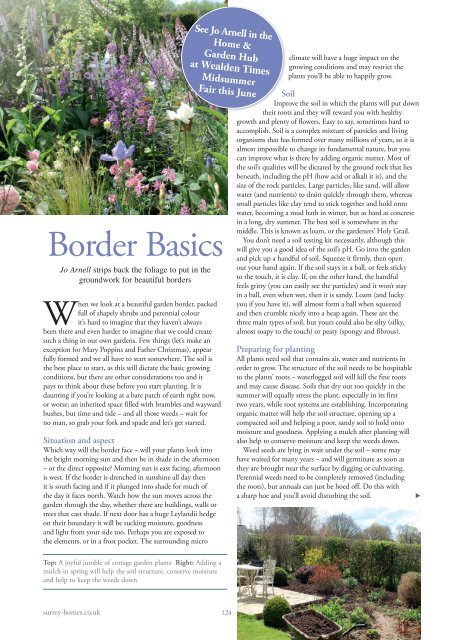Surrey Homes | SH55 | May 2019 | Extensions & Outdoor Living supplement inside
The lifestyle magazine for Surrey - Inspirational Interiors, Fabulous Fashion, Delicious Dishes
The lifestyle magazine for Surrey - Inspirational Interiors, Fabulous Fashion, Delicious Dishes
You also want an ePaper? Increase the reach of your titles
YUMPU automatically turns print PDFs into web optimized ePapers that Google loves.
Border Basics<br />
Jo Arnell strips back the foliage to put in the<br />
groundwork for beautiful borders<br />
When we look at a beautiful garden border, packed<br />
full of shapely shrubs and perennial colour<br />
it’s hard to imagine that they haven’t always<br />
been there and even harder to imagine that we could create<br />
such a thing in our own gardens. Few things (let’s make an<br />
exception for Mary Poppins and Father Christmas), appear<br />
fully formed and we all have to start somewhere. The soil is<br />
the best place to start, as this will dictate the basic growing<br />
conditions, but there are other considerations too and it<br />
pays to think about these before you start planting. It is<br />
daunting if you’re looking at a bare patch of earth right now,<br />
or worse; an inherited space filled with brambles and wayward<br />
bushes, but time and tide – and all those weeds – wait for<br />
no man, so grab your fork and spade and let’s get started.<br />
Situation and aspect<br />
Which way will the border face – will your plants look into<br />
the bright morning sun and then be in shade in the afternoon<br />
– or the direct opposite? Morning sun is east facing, afternoon<br />
is west. If the border is drenched in sunshine all day then<br />
it is south facing and if it plunged into shade for much of<br />
the day it faces north. Watch how the sun moves across the<br />
garden through the day, whether there are buildings, walls or<br />
trees that cast shade. If next door has a huge Leylandii hedge<br />
on their boundary it will be sucking moisture, goodness<br />
and light from your side too. Perhaps you are exposed to<br />
the elements, or in a frost pocket. The surrounding micro<br />
See Jo Arnell in the<br />
Home &<br />
Garden Hub<br />
at Wealden Times<br />
Midsummer<br />
Fair this June<br />
climate will have a huge impact on the<br />
growing conditions and may restrict the<br />
plants you’ll be able to happily grow.<br />
Soil<br />
Improve the soil in which the plants will put down<br />
their roots and they will reward you with healthy<br />
growth and plenty of flowers. Easy to say, sometimes hard to<br />
accomplish. Soil is a complex mixture of particles and living<br />
organisms that has formed over many millions of years, so it is<br />
almost impossible to change its fundamental nature, but you<br />
can improve what is there by adding organic matter. Most of<br />
the soil’s qualities will be dictated by the ground rock that lies<br />
beneath, including the pH (how acid or alkali it is), and the<br />
size of the rock particles. Large particles, like sand, will allow<br />
water (and nutrients) to drain quickly through them, whereas<br />
small particles like clay tend to stick together and hold onto<br />
water, becoming a mud bath in winter, but as hard as concrete<br />
in a long, dry summer. The best soil is somewhere in the<br />
middle. This is known as loam, or the gardeners’ Holy Grail.<br />
You don’t need a soil testing kit necessarily, although this<br />
will give you a good idea of the soil’s pH. Go into the garden<br />
and pick up a handful of soil. Squeeze it firmly, then open<br />
out your hand again. If the soil stays in a ball, or feels sticky<br />
to the touch, it is clay. If, on the other hand, the handful<br />
feels gritty (you can easily see the particles) and it won’t stay<br />
in a ball, even when wet, then it is sandy. Loam (and lucky<br />
you if you have it), will almost form a ball when squeezed<br />
and then crumble nicely into a heap again. These are the<br />
three main types of soil, but yours could also be silty (silky,<br />
almost soapy to the touch) or peaty (spongy and fibrous).<br />
Preparing for planting<br />
All plants need soil that contains air, water and nutrients in<br />
order to grow. The structure of the soil needs to be hospitable<br />
to the plants’ roots – waterlogged soil will kill the fine roots<br />
and may cause disease. Soils that dry out too quickly in the<br />
summer will equally stress the plant, especially in its first<br />
two years, while root systems are establishing. Incorporating<br />
organic matter will help the soil structure, opening up a<br />
compacted soil and helping a poor, sandy soil to hold onto<br />
moisture and goodness. Applying a mulch after planting will<br />
also help to conserve moisture and keep the weeds down.<br />
Weed seeds are lying in wait under the soil – some may<br />
have waited for many years – and will germinate as soon as<br />
they are brought near the surface by digging or cultivating.<br />
Perennial weeds need to be completely removed (including<br />
the roots), but annuals can just be hoed off. Do this with<br />
a sharp hoe and you’ll avoid disturbing the soil.<br />
<br />
Top: A joyful jumble of cottage garden plants Right: Adding a<br />
mulch in spring will help the soil structure, conserve moisture<br />
and help to keep the weeds down<br />
surrey-homes.co.uk<br />
124


















